Rakesh Bhatnagar of Rave Scan talks about the the journey of 20-year old firm in Delhi and the move to Gurgaon. He tells Supreeth Sudhakaran, that branding has sustained the firm's 37% growth and ensured plans are intact.
Indian printing market is worth 24.1 billion USD, according to you how solid is the growth and in which segment?
Undoubtedly, global economic slowdown has affected our industry as well. The demand of printed work has taken a dip as most of the brand owners have squeezed the budgets which were allocated for printed works, and some have even put major product launches on hold.
Nevertheless, the growth story of the Indian print industry continues. The industry has witnessed mild slowdown but we have seen good growth in book publishing, especially, textbook printing market. A testament to this is that we have experienced growth of over 50% from publishing alone.
Rave Scan achieved a growth of 37% this year as opposed to the expected growth of 55% – a 20% fall is huge but not alarming.
Rave Scan was also planning to expand into packaging segment. What is the status of the plan now?
‘Packaging is a sunrise segment’ is now an oft-quoted cliché, yet it is true. Last year, we announced our plans to enter packaging printing in a big way, since we already have multiple machines for printing. The Rs 200-cr project has been revised considering the economic slowdown, but we haven’t shelved the plan. Now we plan to make a gradual move into the segment with a phase-by-phase expansion. We have already started adding machines in our finishing units, and bigger plans will unfold once the situation stabilises. The current focus is to develop a unit that will specialise in mono carton and flute-packaging.
In the last couple of years, Rave Scan has been working on its brand strategies, and it has started to pay off now. How difficult was it?
Today, branding is no more an additional activity but necessity for any organisation. We achieved 37% growth in such tough conditions of the slowdown only because of branding. We adopted a corporate style of working and appointed qualified departmental heads who ensured smooth functioning while the top management formulated strategies.
We never tried to attain awards and certification but kept our customers informed about the latest developments at the company through our in-house newsletter. The circulation of the newsletter is more than 4,000. Though it is a free-of-cost initiative, it has given a boost to our branding and indirectly helped us to notch up good sales.
Rave Scan has been part of many CSR activities. How difficult was it to break away from the usual route of ‘just going green’?
We have spearheaded different activities such as promoting artists, launching calendars, sponsoring the education of children, etc. Rave Education Fund has been supporting several meritorious children of our staff for their education.
Responsible companies understand the importance of CSR activities. However, the sub-form or type of philanthropy one wants to practice is subjective. It depends upon many factors such as the kind of knowledge or understanding of the company about the subject, what is the financial status of the company, etc. Whenever you attempt such initiatives, you should feel happy and connected to the cause.

Bhatnagar: "The Rs 200-cr project now has been revised considering the economic slowdown, but we haven't shelved the plan."
The cost of raw materials has been increasing while printers have been under constant pressure from clients to reduce their cost per print. How has Rave managed such conditions?
Increasing the price of print is a tricky situation for even established printers. Printers are in a catch 22 situation. If they increase the price, they lose the client; if they don’t, it critically hits the cash registers. We had been working for a book publisher for last six years. Two years ago, we asked the client for a hike in rates because of increasing input cost, and this year we lost the client as they claim that they were offered the services by another printer at 25% lesser price than ours. The only solution we have found is to ensure that the volumes increase every year and that all efforts are taken to sustain the business. Simultaneously, it is imperative to reduce the makeready times and increase production per shift to improve the overall yield per personnel.
How much does standardisation and automation help in all this?
As a matter of fact, 100% standardisation is a myth, and it cannot be achieved in printing because of involvement of many components and process. There are around 150 parameters which affect the print. Furthermore, the quandary of whether to go with visual appearance of the print or the colour values, still persists. Indian print industry is largely supported by manual operations. However, I have seen printed samples from fully-automated print company in European countries, but even they show variations.
Change in chemistry of inputs and pressroom discipline also affects the prints. Therefore, we have always engaged our input providers to keep us abreast with the changes in the chemistry of their products. Colour management, correction and other software really help in setting and maintaining profiles, which help in attaining certain level of standardisation in the print quality. However, there’s no absolute fool-proof methodology, yet.
The apex court of India recently cleared the hurdles for FDI in retail. Do you believe that the decision will lift the spirits of the industry for the fiscal 2013?
I am a practitioner of calculated optimism, and therefore, I believe that 2013 will be a better year for the industry. Having said that, we also need to be practical because market gurus have projected the global economic growth rate to be sluggish.
In the last three years, I have seen major expansions by printers in Delhi NCR. A majority of these were banking on the approval for FDI in retail. The current production capacity and the setups won’t be able to sustain and feed the demand generated once the policy comes into force. A lopsided investment only eyeing the print part of the packaging jobs is myopic in my view. The need of the hour is to have a holistic growth plan to meet not only the demand of print but to have a setup that can offer a 360 degree solution to the customer.
Do you believe the Union budget fell far short of expectation for the printing industry?
Yes, the last budget had almost nothing for the industry. We are expecting GST to eliminate the irregularities which are still functional in industry. Small players register their firms under different names and as soon as one of the companies hits the excise duty circle, they register another company, thus gaining margin. GST will definitely help players like us who follow ethical business practices.
You have always seemed concerned about how print is an ignored industry…
We are as big as the automobile industry, yet we live an oblivious existence. There are many small industries like leather, gems and stones, etc. that have delegates who are parts of organisations like FICCI and CII and are usually engaged by the government to understand the concerns of India Inc. But we are not part of any of these. We are an essential part of any industry because you cannot sell anything without printing and packaging, but people do not understand that.
A lot of it has to do with the fact that haven’t yet succeeded getting out of the epithet of being a chapakhana. I feel the issue with us is that we have been shouting amidst chaos. We need to put our problems and messages on right platforms with efficient force. Government always listens to the associations but only if the association talks in unity, which I am afraid, we are yet to attain. We all share the same concerns but the big question is who will bell the cat?












 See All
See All